Showing Spotlights 1889 - 1896 of 2798 in category All (newest first):
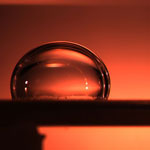 Surface energy is ubiquitous in nature and it plays an important role in many scientific areas such as for instance surface physics, biophysics, surface chemistry, or catalysis. So far it has been impractical to consider utilizing surface energy as an energy source because there are few molecules or atoms involved in the surface interaction and the density of surface energy is low. However, due to the lower power consumption requirements of nanotechnology devices and the higher specific surface area for nanomaterials it appears attractive to use surface energy at the nanoscale. Researchers in China have now demonstrated that an effective design of single-walled carbon nanotubes can be used to convert the surface energy of liquids into electricity.
Surface energy is ubiquitous in nature and it plays an important role in many scientific areas such as for instance surface physics, biophysics, surface chemistry, or catalysis. So far it has been impractical to consider utilizing surface energy as an energy source because there are few molecules or atoms involved in the surface interaction and the density of surface energy is low. However, due to the lower power consumption requirements of nanotechnology devices and the higher specific surface area for nanomaterials it appears attractive to use surface energy at the nanoscale. Researchers in China have now demonstrated that an effective design of single-walled carbon nanotubes can be used to convert the surface energy of liquids into electricity.
Mar 5th, 2010
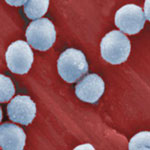 In 2008, the Joint Research Centre, Institute for Health and Consumer Protection of the European Commission funded the project Engineered Nanoparticles: Review of Health and Environmental Safety (ENRHES). Last month, the ENRHES project released its final report. The overall aim of the ENRHES project was to perform a comprehensive and critical scientific review of the health and environmental safety of four classes of nanomaterials: fullerenes, carbon nanotubes, metals and metal oxides. The review considers sources, pathways of exposure, the health and environmental outcomes of concern, illustrating the state-of-the-art and identifying knowledge gaps in the field, in order to coalesce the evidence which has emerged to date and inform regulators of the potential risks of engineered nanoparticles in these specific classes.
In 2008, the Joint Research Centre, Institute for Health and Consumer Protection of the European Commission funded the project Engineered Nanoparticles: Review of Health and Environmental Safety (ENRHES). Last month, the ENRHES project released its final report. The overall aim of the ENRHES project was to perform a comprehensive and critical scientific review of the health and environmental safety of four classes of nanomaterials: fullerenes, carbon nanotubes, metals and metal oxides. The review considers sources, pathways of exposure, the health and environmental outcomes of concern, illustrating the state-of-the-art and identifying knowledge gaps in the field, in order to coalesce the evidence which has emerged to date and inform regulators of the potential risks of engineered nanoparticles in these specific classes.
Mar 4th, 2010
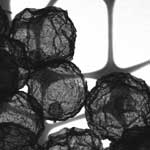 Among various nanomaterial candidates for water treatment, metal oxides have been widely used as removal agents for various heavy metal ions and their removal capacity was found to be relatively reliable. The removal mechanism for heavy metal ions is thought to be the formation of a strong bond between metal ions and metal oxide surfaces. This strong complexation is advantageous for complete removal of heavy metal ions but it presents a drawback if one wants to design a reusable agent by reviving the reaction site for heavy metal ions. Precisely because the removal mechanism is based on the strong complex formation between metal ions and oxide surfaces, recycling of these removal agents has proved to be difficult. Offering a potential solution, researchers have demonstrated a recyclable removal agent for heavy metal ions by fabricating a core-in-shell structure based on a core of carbon nanotubes and an iron oxide microcapsule structure.
Among various nanomaterial candidates for water treatment, metal oxides have been widely used as removal agents for various heavy metal ions and their removal capacity was found to be relatively reliable. The removal mechanism for heavy metal ions is thought to be the formation of a strong bond between metal ions and metal oxide surfaces. This strong complexation is advantageous for complete removal of heavy metal ions but it presents a drawback if one wants to design a reusable agent by reviving the reaction site for heavy metal ions. Precisely because the removal mechanism is based on the strong complex formation between metal ions and oxide surfaces, recycling of these removal agents has proved to be difficult. Offering a potential solution, researchers have demonstrated a recyclable removal agent for heavy metal ions by fabricating a core-in-shell structure based on a core of carbon nanotubes and an iron oxide microcapsule structure.
Mar 3rd, 2010
 Solar cells, or photovoltaic cells, are used to convert sunlight into electrical power. As traditional power sources grow scarce, other forms of producing electrical power are gaining firm footing in the power supply mix. Solar cells are already widely used in a variety of applications - from spacecraft, to small portable devices, to farm installations, to roadway signs. As energy prices increase, public demand for solar power has surged. In order to meet the longevity, yield, and price requirements of consumers and industry, public and private sector research has increased dramatically. While traditional tools are helpful to investigate and improve solar cells, AFM/SPM offers metrology, topography and roughness analysis at much higher resolution than with optical techniques.
Solar cells, or photovoltaic cells, are used to convert sunlight into electrical power. As traditional power sources grow scarce, other forms of producing electrical power are gaining firm footing in the power supply mix. Solar cells are already widely used in a variety of applications - from spacecraft, to small portable devices, to farm installations, to roadway signs. As energy prices increase, public demand for solar power has surged. In order to meet the longevity, yield, and price requirements of consumers and industry, public and private sector research has increased dramatically. While traditional tools are helpful to investigate and improve solar cells, AFM/SPM offers metrology, topography and roughness analysis at much higher resolution than with optical techniques.
Mar 2nd, 2010
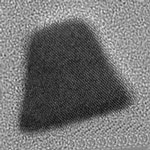 All existing transistors are based on junctions - obtained by changing the polarity of silicon from positive to negative. Researchers have now demonstrated a new type of transistor in which there are no junctions and no doping concentration gradients. The key to fabricating a junctionless gated resistor is the formation of a semiconductor layer that is thin and narrow enough to allow for full depletion of carriers when the device is turned off - something that was achieved by fabricating silicon nanowires with a diameter of a few dozens of atomic planes. The electrical current flows in this silicon nanowire, and the flow of current is perfectly controlled by a ring structure that electrically squeezes the silicon wire in the same way that you might stop the flow of water in a hose by squeezing it.
All existing transistors are based on junctions - obtained by changing the polarity of silicon from positive to negative. Researchers have now demonstrated a new type of transistor in which there are no junctions and no doping concentration gradients. The key to fabricating a junctionless gated resistor is the formation of a semiconductor layer that is thin and narrow enough to allow for full depletion of carriers when the device is turned off - something that was achieved by fabricating silicon nanowires with a diameter of a few dozens of atomic planes. The electrical current flows in this silicon nanowire, and the flow of current is perfectly controlled by a ring structure that electrically squeezes the silicon wire in the same way that you might stop the flow of water in a hose by squeezing it.
Mar 1st, 2010
 Eric Drexler attempts to answer the question on how students should prepare for a career in nanotechnology. His advice centers on fundamentals, outlining areas of knowledge are are universally important, and offering suggestions for how to approach both specialized choices and learning in general. It includes observations about the future of nanotechnology, the context for future careers. However, as you might imagine, providing a good answer is challenging. 'Nanotechnology' refers to a notoriously broad range of areas of science and technology, and progress during a student's career will open new areas, and some are yet to be imagined. Choices within this complex and changing field should reflect a student's areas of interest and ability, current background, level of ambition, and willingness to to accept risk - there is a trade-off between pioneering new directions and seeking a secure career path.
Eric Drexler attempts to answer the question on how students should prepare for a career in nanotechnology. His advice centers on fundamentals, outlining areas of knowledge are are universally important, and offering suggestions for how to approach both specialized choices and learning in general. It includes observations about the future of nanotechnology, the context for future careers. However, as you might imagine, providing a good answer is challenging. 'Nanotechnology' refers to a notoriously broad range of areas of science and technology, and progress during a student's career will open new areas, and some are yet to be imagined. Choices within this complex and changing field should reflect a student's areas of interest and ability, current background, level of ambition, and willingness to to accept risk - there is a trade-off between pioneering new directions and seeking a secure career path.
Feb 26th, 2010
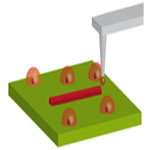 Numerous research groups around the world are inspired by the biomineralization processes found in nature - the process by which living organisms produce inorganic materials (minerals) found in bones, teeth, or shells. In this process, the formation of the mineral is controlled with great precision by specialized organic biomolecules such as sugars and proteins. Whereas the fabrication of many man-made crystals requires elevated temperatures and strong chemical solutions, nature's organisms have long been able to lay down elaborate mineral structures at ambient temperatures. Being able to duplicate nature's 'production process' would potentially allow for much simpler and 'greener' fabrication technologies than the ones employed today. To that end, researchers have developed a new nanofabrication methodology to generate crystalline oxide semiconductor nanopatterns under mild conditions.
Numerous research groups around the world are inspired by the biomineralization processes found in nature - the process by which living organisms produce inorganic materials (minerals) found in bones, teeth, or shells. In this process, the formation of the mineral is controlled with great precision by specialized organic biomolecules such as sugars and proteins. Whereas the fabrication of many man-made crystals requires elevated temperatures and strong chemical solutions, nature's organisms have long been able to lay down elaborate mineral structures at ambient temperatures. Being able to duplicate nature's 'production process' would potentially allow for much simpler and 'greener' fabrication technologies than the ones employed today. To that end, researchers have developed a new nanofabrication methodology to generate crystalline oxide semiconductor nanopatterns under mild conditions.
Feb 24th, 2010
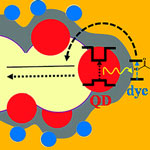 While the dye sensitized photovoltaic cell is a fairly mature design, researchers are still trying to improve its efficiency with various techniques, including structuring nanoporous electrodes to provide higher surface area and better charge transport, replacement of the liquid electrolyte by a solid one in order to prevent the electrolyte evaporation, and ways to widen the narrow absorption spectra of molecular dyes. In a standard DSSC, an organic molecule adsorbed on the surface of a porous electrode absorbs light and then initiates the charge separation process eventually leading to generation of photocurrent. One major difficulty in such cells is that very few dyes can absorb a broad spectral range, essentially covering the solar spectrum. In contrast, broad spectral coverage is an inherent property of semiconductor nanocrystals. The latter, however, turn out to do a rather lousy job in separating the charges. Researchers in Israel have now presented a new configuration for quantum dot sensitized DSSCs via a FRET process.
While the dye sensitized photovoltaic cell is a fairly mature design, researchers are still trying to improve its efficiency with various techniques, including structuring nanoporous electrodes to provide higher surface area and better charge transport, replacement of the liquid electrolyte by a solid one in order to prevent the electrolyte evaporation, and ways to widen the narrow absorption spectra of molecular dyes. In a standard DSSC, an organic molecule adsorbed on the surface of a porous electrode absorbs light and then initiates the charge separation process eventually leading to generation of photocurrent. One major difficulty in such cells is that very few dyes can absorb a broad spectral range, essentially covering the solar spectrum. In contrast, broad spectral coverage is an inherent property of semiconductor nanocrystals. The latter, however, turn out to do a rather lousy job in separating the charges. Researchers in Israel have now presented a new configuration for quantum dot sensitized DSSCs via a FRET process.
Feb 23rd, 2010
 Surface energy is ubiquitous in nature and it plays an important role in many scientific areas such as for instance surface physics, biophysics, surface chemistry, or catalysis. So far it has been impractical to consider utilizing surface energy as an energy source because there are few molecules or atoms involved in the surface interaction and the density of surface energy is low. However, due to the lower power consumption requirements of nanotechnology devices and the higher specific surface area for nanomaterials it appears attractive to use surface energy at the nanoscale. Researchers in China have now demonstrated that an effective design of single-walled carbon nanotubes can be used to convert the surface energy of liquids into electricity.
Surface energy is ubiquitous in nature and it plays an important role in many scientific areas such as for instance surface physics, biophysics, surface chemistry, or catalysis. So far it has been impractical to consider utilizing surface energy as an energy source because there are few molecules or atoms involved in the surface interaction and the density of surface energy is low. However, due to the lower power consumption requirements of nanotechnology devices and the higher specific surface area for nanomaterials it appears attractive to use surface energy at the nanoscale. Researchers in China have now demonstrated that an effective design of single-walled carbon nanotubes can be used to convert the surface energy of liquids into electricity. 
 Subscribe to our Nanotechnology Spotlight feed
Subscribe to our Nanotechnology Spotlight feed





